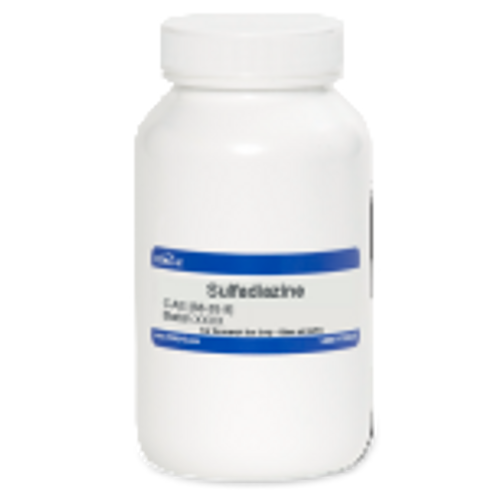Sulfadiazine sodium is a sulfonamide antibiotic that was developed in 1940 by Richard Roblin at the Stamford Research Laboratories of the American Cyanamid Company to be a more potent and less toxic alternative to Sulfapyridine. Sulfadiazine is a bacteriostatic folic acid synthesis inhibitor that shows broad spectrum activity against gram-positive bacteria, gram-negative bacteria and Chlamydia.
Sulfadiazine sodium is a competitive inhibitor of the bacterial enzyme dihydropteroate synthetase. This enzyme is needed for the proper processing of para-aminobenzoic acid (PABA) which is essential for folic acid synthesis. The inhibited reaction is necessary in these organisms for the synthesis of folic acid.
Sulfadiazine sodium dissolves freely in water (50mg/mL).
Synonyms: 4-Amino-N-(2-pyrimidinyl)benzenesulfonamide sodium salt, N1-(Pyrimidin-2-yl)sulfanilamide sodium
| Mechanism of Action | Sulfadiazine sodium is a competitive inhibitor of the bacterial enzyme dihydropteroate synthetase. This enzyme is needed for the proper processing of para-aminobenzoic acid (PABA) which is essential for folic acid synthesis. The inhibited reaction is necessary in these organisms for the synthesis of folic acid. |
| Spectrum | Sulfadiazine sodium is a broad-spectrum antibiotic targeting a wide range of gram-positive and gram-negative bacteria especially those which cause urinary tract infections. |
| Microbiology Applications | Sulfadiazine sodium is commonly used in clinical in vitromicrobiological antimicrobial susceptibility tests (panels, discs, and MIC strips) against gram positive and gram negative microbial isolates. Medical microbiologists use AST results to recommend antibiotic treatment options for infected patients. Representative MIC values include:
Sulfadiazine is a component of SPS agar (Sulfite Polymyxin Sulfadizine Agar), that can be used for the detection, isolation, and emuneration of Clostridium perfringens and Clostridium botulinum in food; as well as the detection of V. cholerae and V. vulnificus in the environment. Sulfadiazine is commonly used with pyrimethamine to treat toxoplasmosis in patients with acquired immunodeficiency syndrome. It is also used to treat newborns with congenital infections. Sulfadiazine has been used to control acute infections when studying murine models of reactivated toxoplasmosis. |
| Plant Biology Applications | Sulfadiazine sodium is a herbicide that is able to inhibit folic acid synthesis in plants. Sulfadiazine and the resistance gene sul, create an effective selection system for the creation of transgenic tobacco and algae. Co‐transformation experiments in tobacco revealed that sul is even superior to nptII, the currently most efficient selectable marker gene, and thus provides an attractive marker for the high‐throughput genetic transformation of plants and algae |
| Molecular Formula | C10H9N4NaO2S |
| References | "Sulfadiazine: Mechanism of Action." Cancer News Network. N.p., 2009. Web. 21 Aug. 2012. |








